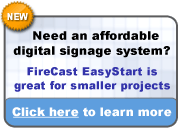I originally wasn't going to post anything about this article by BroadSign posted over at aka.tv. Over the years aka has been a pretty reliable source for industry news, and if they want to slip an occasional advertorial from one of their biggest sponsors in, I'm ok with that. I'm a businessman, I can understand some firms might need to do those kinds of things from time to time, and I can filter them out, just like most people.
But after the fourth or fifth email from somebody saying "OMG OMG DIDYOUSEETHIS!?!" and acting as if I should be concerned or offended, I've decided that it'll be faster and more efficient to just post something now so I can point to it later :)
The article in question asks whether a Linux- or Windows-based technology platform is best for digital signage. WireSpring and a few others make Linux-based stuff. Pretty much everybody else uses Windows. Consequently, we do need to defend our decision on occasion, mostly to technical folks who know just enough to be dangerous. But rather than discuss technical merit or the pros and cons of the different kernel architectures, etc., I've found it much better to approach this discussion from a business perspective. So here it is, the secret sauce, the reason why this argument should be irrelevant by now:
Digital signage should NOT be approached as a tech project.
If you're an IT or AV guy, this might sound a bit disheartening, and you might not even believe it. Sure, there are computers and networks and screens and whatnot, but the way one sells a digital signage network into a venue (in my experience at least) is to explain what the screen can do, not how it works. Most people, deep down, couldn't care less whether their media players run Windows or Linux. What they do care about, are things like:
- Will it play content the way I want it to?
- Can I set it up to look different at different times and in different places?
- Can I control it remotely?
- Will it be stable and reliable - can I count on 24/7 playback?
- Will it be secure, or will it get infected with viruses and spyware if I'm not keeping an eye on it?
- Am I going to need to upgrade it?
- What other 3rd party software/services will I need to make it work?
- Is it affordable and cost-effective, both up-front and considering lifetime TCO?
- Do I have to worry about licensing?
It's hard enough making a compelling digital signage network that's full of amazing content and meets a bunch of high-level business objectives. Throwing in capacity planning, server scalability, failover redundancy, player OS upgrades, anti-virus subscriptions and security patching just doesn't make any sense to me.
Would-be commenters beware: I make judicious use of the "delete comment" button. I'm not going to censor anybody's opinion, but if you post an obvious flame or an advertisement, it's going to get dropped in a hurry.
Tags: digital signage software, Linux, Windows


 Subscribe to this blog
Subscribe to this blog Follow Bill Gerba on Twitter
Follow Bill Gerba on Twitter
4 comments:
You said, there are technical parts of digital signage projects. In the projects I've done they are usually the most expensive part. Don't you think I should check and see if the hardware and software is going to do all of the things you list, and what I need if I'm spending so much money on them? What if I don't know anything about Linux? That would be an important part of my business decision.
True, digital signage networks are big digital/electronic/technical projects, but I never said otherwise. What I did say was they shouldn't be approached as tech projects in general, because that shifts the emphasis to the up-front cap expenditure and the early logistical portions of the project, not leaving enough attention/budget dollars/whatever for the interdisciplinary work (e.g. getting marketing, merchandising, inventory, purchasing, etc.) involved, and most importantly, not giving enough focus to the content that will appear on the screens, both initially and over time.
To your question about whether a firm's lack of Linux/Windows/Mac knowledge should ever come into play, again I'd say no. I don't want to turn this into an advertisement, but using my company's Linux-based FireCast as an example, we assume our customers have ZERO Linux knowledge. The product abstracts all of the low-level IT and networking stuff into some tools that the average person can use to quickly get set up. We don't think that a digital sign administrator should have to even think about the underpinnings of a product. If and when the odd network- or system-related problem does crop up, we, the service provider, are responsible for fixing it.
If you don't think that's a tenable solution for the typical project (even a very large one), we have a lot of customers that would suggest otherwise. In fact, the bigger the project, the more the customer realizes how true this is.
I think the phrase "one neck to strangle" is the most powerful marketing statement you could make.
Given that, buyers should not care what's underneath, and if your stuff is as good as you say it is, they may not ever know.
I think the phrase "one neck to strangle" is the most powerful marketing statement you could make.
Given that, buyers should not care what's underneath, and if your stuff is as good as you say it is, they may not ever know.
Post a Comment